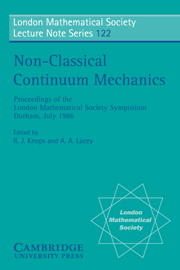 Non-Classical Continuum Mechanics
Non-Classical Continuum Mechanics Published online by Cambridge University Press: 11 May 2010
Abstract. Among elastic crystals which are subjected to phase transitions are those which represent so-called ferroic states. These are elastic ferroelectrics, elastic ferromagnets and ferroelastic crystals such as twinned shape-memory materials. In these three wide classes studied by the author and co-workers, the solitary waves which can be shown to exist and represent either moving domain walls or nuclei of transformations, are not true solitons since the interaction of two such waves always is accompanied by some linear radiation. This is a consequence of the very form of the governing systems of equations which may be of different types (e.g., sine-Gordon equation coupled to wave equations, modified Boussinesq equation) and are usually obtained either from a discrete lattice model or a rotationally invariant continuum model. For the sake of illustration the case of shape-memory materials is presented in greater detail through the first approach.
INTRODUCTION
Nearby, but below, the order-disorder phase-transition temperature, the dynamical equations that govern elastic crystals with a microstructure exhibit all the necessary, if not sufficient, properties (essentially, nonlinearity and dispersion with a possible compensation between the two effects) to allow for the propagation of so-called solitary waves. Whether these are true solitons or not is a question that can be answered only in each case through analysis and/or numerical simulations. These waves, however, are supposed to represent domain walls in motion. The latter are layers of relatively small thickness which carry a strong nonuniformity in a relevant parameter between two adjacent phases or degenerate ground states (see, e.g., Maugin and Pouget, 1986).
To save this book to your Kindle, first ensure [email protected] is added to your Approved Personal Document E-mail List under your Personal Document Settings on the Manage Your Content and Devices page of your Amazon account. Then enter the ‘name’ part of your Kindle email address below. Find out more about saving to your Kindle.
Note you can select to save to either the @free.kindle.com or @kindle.com variations. ‘@free.kindle.com’ emails are free but can only be saved to your device when it is connected to wi-fi. ‘@kindle.com’ emails can be delivered even when you are not connected to wi-fi, but note that service fees apply.
Find out more about the Kindle Personal Document Service.
To save content items to your account, please confirm that you agree to abide by our usage policies. If this is the first time you use this feature, you will be asked to authorise Cambridge Core to connect with your account. Find out more about saving content to Dropbox.
To save content items to your account, please confirm that you agree to abide by our usage policies. If this is the first time you use this feature, you will be asked to authorise Cambridge Core to connect with your account. Find out more about saving content to Google Drive.